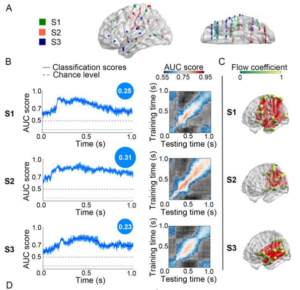Consistent gradient of performance and decoding of stimulus type and valence from local and network activity
Transactions on Neural Systems & Rehabilitation Engineering
Hesse, E., Mikulan, E., Sitt, J., García, M., Silva, W., Ciraolo, C., Vaucheret, E., Raimondo, F., Baglivo, F., Adolfi, F., Herrera, E., Bekinschtein, T., Petroni, A., Lew, S., Sedeño, L., García, A. M. & Ibáñez, A. (2019). Consistent gradient of performance and decoding of stimulus type and valence from local and network activity. Transactions on Neural Systems & Rehabilitation Engineering 27(4), 619-629. Online: http://bit.ly/2ItE1PP.
En este trabajo, realizado con registros intracraneales directos en humanos, utilizamos aprendizaje automático de máquinas de la actividad cerebral, para decodificar y predecir el desempeño del procesamiento emocional y de diferentes estímulos a nivel individual.
Para acceder al artículo completo hacé click AQUÍ
Consistent gradient of performance and decoding of stimulus type and valence from local and network activity
Transactions on Neural Systems & Rehabilitation Engineering
Hesse, E., Mikulan, E., Sitt, J., García, M., Silva, W., Ciraolo, C., Vaucheret, E., Raimondo, F., Baglivo, F., Adolfi, F., Herrera, E., Bekinschtein, T., Petroni, A., Lew, S., Sedeño, L., García, A. M. & Ibáñez, A. (2019). Consistent gradient of performance and decoding of stimulus type and valence from local and network activity. Transactions on Neural Systems & Rehabilitation Engineering 27(4), 619-629. Online: http://bit.ly/2ItE1PP.
The individual differences approach focuses on the variation of behavioral and neural signatures across subjects. In this context, we searched for intracranial neural markers of performance in three individuals with distinct behavioral patterns (efficient, borderline, and inefficient) in a dual-valence task assessing facial and lexical emotion recognition. First, we performed a preliminary study to replicate well-established evoked responses in relevant brain regions. Then, we examined time series data and network connectivity, combined with multivariate pattern analyses and machine learning, to explore electrophysiological differences in resting-state versus task-related activity across subjects. Next, using the same methodological approach, we assessed the neural decoding of performance for different dimensions of the task. The classification of time series data mirrored the behavioral gradient across subjects for stimulus type but not for valence. However, network-based measures reflected the subjects’ hierarchical profiles for both stimulus types and valence. Therefore, this measure serves as a sensitive marker for capturing distributed processes such as emotional valence discrimination, which relies on an extended set of regions. Network measures combined with classification methods may offer useful insights to study single subjects and understand inter-individual performance variability. Promisingly, this approach could eventually be extrapolated to other neuroscientific techniques.
To access the full paper please click HERE



